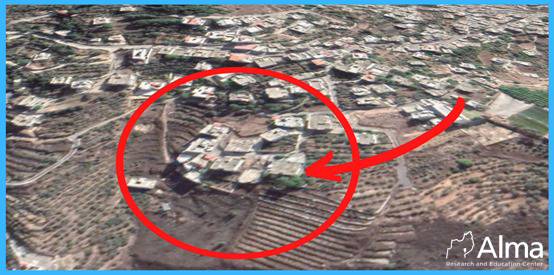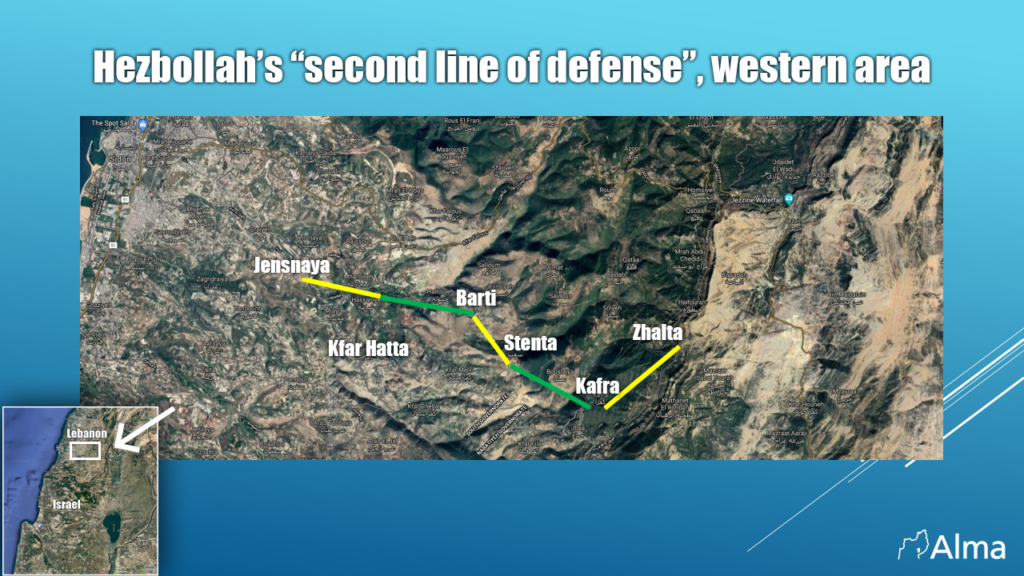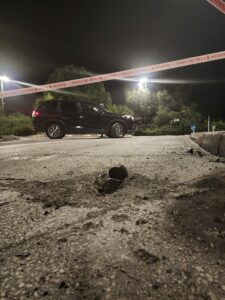This report reveals six military sites used by Hezbollah in southern Lebanon in the geographical area north of the city of Nabatieh. This geographic area is part of Hezbollah’s “second line of defense”, which stretches from north of the Litani River across to the Zahrani River (Hezbollah’s “first line of defense” stretches from the Israeli border up to the Litani River).
The sites are located in buildings within the populated villages and areas very close to the villages. The areas near the villages were declared closed military zones by Hezbollah, the entrance to these areas for civilians is prohibited. Hezbollah confiscated some of the lands in those areas from the civilian landowners. In cases where Hezbollah did not confiscate the land in the area declared as a closed military zone, the residents must request explicit permission from Hezbollah’s regional security commander in order to make any use of the land.
Some of these sites are utilized by the missile and rocket array system for their storage and/ or as launch sites. Other parts of these sites are used by the engineering unit and some are used as bunkers and structures for storing weapons including rockets.

The material we located online on Twitter, from August 07, 2020, states that Hezbollah’s engineering unit is manufacturing IEDs in a building in the town of Ain Qana, located in the geographical area called Aqlim al Toufah in southern Lebanon (north of the city of Nabatieh). It also states that Hezbollah stores large quantities of explosives in the building. An aerial photograph indicating the area of the building in Ain Qana accompanied the tweet. The name of the above Twitter account is undisclosed for security reasons. We do not know if the account name and identity are genuine, they may actually be fake. The Twitter account is closed for now.
At noon, September 22, 2020, about a month and a half after the information regarding the building in Ain Qana was published, a large explosion, heard throughout southern Lebanon, occurred in the building in question:

Many indications, collected by us during the hours after the explosion and based on Hezbollah’s modus operandi, pointed to one clear conclusion: the explosion took place in the village in a building belonging to Hezbollah used to store weapons as part of the human shield tactic.
You can read our exclusive article published in October 2020 about the explosion in Ain Qana that exposed Hezbollah’s use of its “human shield” tactic in southern Lebanon as a cover for its storage of weapons.
The explosion in the building in Ain Qana and the many indications that followed reinforced the reliability of the above source and so we acted to further research the source and the additional information published by it. After processing the information from this source, we were able to find additional information from other sources regarding these sites. The findings of our research are reflected in this report.
Hezbollah estimates that in a future confrontation against Israel, it will be difficult for it to defend itself in the open areas vis-à-vis the IDF, but it sees itself able to maintain, within the urban areas in the villages, its continuum of activity in general and the succession of rocket and missile launches into Israel in particular, maintaining its ability to surprise the IDF using tunnel warfare.
Accordingly, about each of the 200~ Shi’ite villages in the area south of the Zaharani River up to the border with Israel and the adjacent areas have become part of Hezbollah’s military infrastructure and are part of the organization’s “regional defensive plan” – a term used by Hezbollah. This defensive plan is based on two lines of defense. The “first line of defense” stretches from the Israeli border up to the Litani River, and the “second line of defense” stretches from north of the Litani River across to the Zahrani River. In practice, this “defensive plan” actually has an offensive component of rockets designated to be launched at Israel’s Homefront in large quantities.
As part of the human shield tactic in the southern villages, networks of underground combat tunnels and bunkers for storing weapons were built. Intelligence and observation command rooms were established throughout their territory and engineering infrastructures and anti-tank weapons were deployed throughout the villages.
In areas very close to the villages, missile launchers (up to a medium range of about 300 km) and rockets (short-range, tens of km) were deployed and placed under the auspices of the agricultural areas.
Each village has become an independent launching compound that functions as an independent unit with an arsenal of short and medium-range rockets and missiles for targeting the civilian and military Israeli infrastructures.
In “the first line of defense”, i.e., in the villages located in the strip between the Israeli border and the Litani River, Hezbollah deployed a short-range rocket infrastructure, while throughout “the second line of defense”, i.e., in the villages north of the Litani River towards the al-Zaharani River, Hezbollah deployed its medium-range missile infrastructure in addition to its short-range rocket infrastructure. In addition, we are aware that all the various Hezbollah units, such as the Engineering unit, the Radwan units, and other designated units, have various sites for their needs within and near the villages.
It should be noted that the “first line of defense” overlaps with UNIFIL’s area of operation – an area that is supposed to be absent of any illegal military presence by the UNSCR 1701.




















